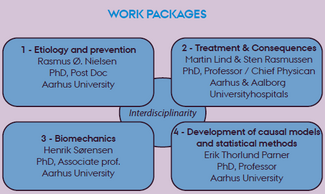Research
RUNSAFE wishes to develop novel, motivating running schedules, which can be used by all runners regardless of their experience. We complete large-scale observational studies and trials; laboratory-based research within biomechanics; and develop novel statistical methods and causal theories.
It is our experience, that collaborations across work packages are necessary, if plausible knowledge about injury etiology, -prevention and –treatment should surface.
RUNSAFE organise the research within 4 work packages: Etiology and prevention, treatment & consequences, biomechanics, and statistics and causality. Each work package has a specific focus, but the multidisciplinarity to other packages is highly valued, in order to create synergy and a common understanding of the research aims. One or two leaders, who report to the research coordinator for RUNSAFE, lead the five work packages. In top of the organization, a leader leads RUNSAFE, while strategies are developed- and central decisions are made in the 6-person management group.
WP 1: Etiology and prevention
Leader: Post Doc, Rasmus Ø. Nielsen, Aarhus University
Web-based tools enables for quantification of running and injury status as well as self-reported data on demographic characteristics, behaviour, motivation, health, and much more. By completing large-scale data collections, we are able to investigate the etiology behind running-related injuries. Target populations are runners in different sizes and shapes, like novices, recreationalists, obese, pregnant. Also, we work within different thematises like diet, running schedules and running shoes. Amongst all groups, it is necessary to investigate, how much the runners are able to run, before an injury occurs, and if there are certain interventions (training modification, diet, shoes, surface), which enables the runners to complete an increased or decreased running load, before injury occurs.
In collaboration with Danish Institute for Sports Studies, epidemiological studies are conducted to examine the prevalence of running injuries in the Danish population.
WP 2: Treatment & Consequences
Leaders:
Professor, Martin Lind, Aarhus University hospital,
Medical Doctor, Sten Rasmussen, Aalborg University hospital
We challenge the existing, strength-oriented rehabilitation programs by investigating running-oriented rehabilitation programs, since we have reason to believe, that certain running injuries can be treated using simple advices on how to schedule the running program. The focus is on the most frequent running injuries like runners´ knee, jumpers´ knee, patellofemoral pain, Achilles tendinopathy, meniscal injuries and plantar fasciitis.
In addition, we will investigate the consequences of running injuries on drug usage, healthcare utilization, absenteeism from work, and time-to-recovery. Finally, amongst the physiotherapists in RUNSAFE treatment we investigate the clinicians´ beliefs about injury etiology and treatment.
WP 3: Biomechanics
Leader: Associate professor, Henrik Sørensen, Aarhus University
In biomechanical laboratories and by using pressure-sensitive insoles in running shoes, we are able to measure who the body is loaded / stressed during running in particular after analysing data with the AnyBody software. With such knowledge, we can examine the size of the load on different structures while running at different running speeds, in different shoes or by changing technique or alignment.
It is necessary, that information be gathered in a valid and reliable manner. Therefore, we complete validation studies on the equipment / devices used for data collections. For instance, this could be validation of accelerometers in smartphones, GPS-watches or pressure-sensitive insoles.
WP 4: Development of causal models and statistical methods
Leader: Professor, Erik Parner, Aarhus University
Causality is the true cause and mechanism of running-related injury. We aim to develop a theoretical model, which describes the complex mechanisms behind injuries in a way, which is biological plausible. To this end, we need to further develop the statistical methods available, since complex causality require very advanced statistical methods in order to analyse data in an appropriate, in-depth manner.
